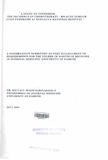A Study to determine the incidence of chemotherapy - related tumour Lysis Syndrome at Kenyatta National Hospital

View/
Date
2005Author
Busakhala, Naftali W
Type
ThesisLanguage
enMetadata
Show full item recordAbstract
Tumour Lysis Syndrome (TLS) is a common occurrence following cancer
treatment. It affects the treatment of both haematological and nonhaematological
tumours with a biochemical incidence of 42% among the acute
leukemias and high grade lymphomas although only 3 - 6%manifest clinically.
Prophylactic measures such as hydration and adminstration of allopurinol are
now widely used but published studies show persistence of the problem. This
has been attributed to increasing use of more intensive and potent
chemotherapeutic agents;
Development of TIS increases chemotherapy;related morbidity and if severe,
mortality yet there are no local studies on TIS.
This was a prospective cohort study conducted at the
Kenyatta National Hospital (a tertiary and national referral center). Patients were
recruited from oncology, medical and Gynaecology wards and also the
,haematology-Oncology, and radiotherapy clinics.
The study population consisted of patients with a confirmed tissue diagnosis of
cancer receiving the first course of chemotherapy.
Patients with a tissue diagnosis of cancer for whom chemotherapy had been
prescribed were introduced to the study by use of the patient explanation form
shown in appendix 1.
Those who met the inclusion criteria and signed the consent form were
consecutively recruited into the study. Two milliliters of venous blood was
withdrawn before starting chemotherapy and thereafter daily for four days.
Serum potassium, phosphate, calcium and uric acid were measured. Patients
who developed TLS had repeat measurements on day 7 to check for resolution.
Those who had not resolved had measurements repeated on day 15.
TLS was defined as a rise in serum potassium, phosphate and uric acid or decline
in serum calcium by 25% occurring within four days of starting chemotherapy. A
minimum of 2 out of these 4 biochemical changes were required for diagnosis of
TLS.
A total number of 142 cancer patients were recruited. Out of these, 31 dropped
out of the study thus leaving 111 patients for analysis. Incidence of TLS was
found to be 37.83%(,95% CI= 31.27-44.29).
Incidence of TLS in the haematological malignancies was 75.5%(95% CI=67.64-
83.37%) and in the non-haematological maligrtancies, it was 3.6%(95% CI=-O.8-
7.8%). Potassium and phosphate were the most consistent diagnostic parameters
while only one patient had a rise in uric acid and no patient had a decline in
calcium by 25% from baseline. Fifty percent of TLS cases developed on day 1
and 42.9% resolved in the second week.
The incidence of TLS at Kenyatta National Hospital from this study is
37.83%(95% CI= 31.27-44.29).
Most of the TLS cases were diagnosed on the basis of increase in serum
potassium and phosphate.
Uric acid levels did not appear to rise as would have been expected except in
in one patient who received doxorubicin for abdominal rhabdomyosarcoma.
Citation
Masters of MedicinePublisher
University of Nairobi School of Medicine
Collections
- Faculty of Health Sciences (FHS) [4487]
- Theses & Dissertations [241]
